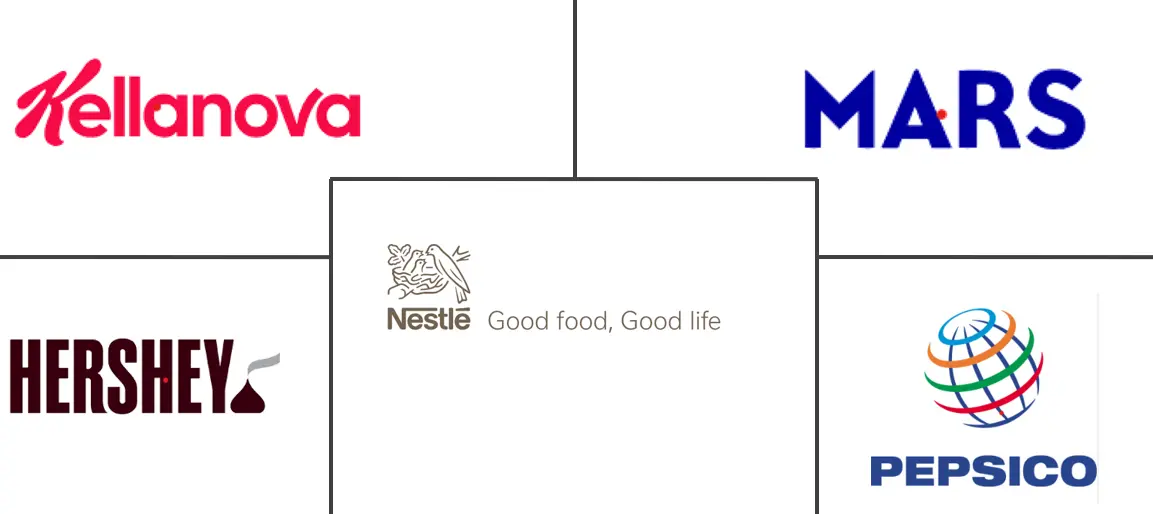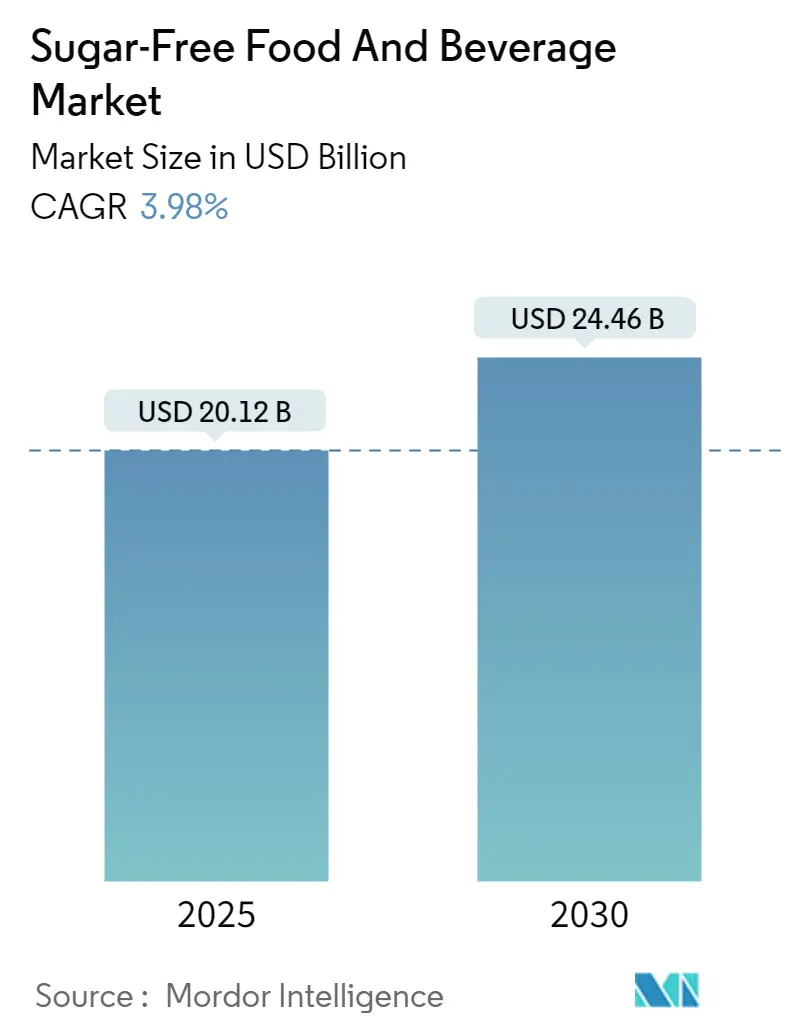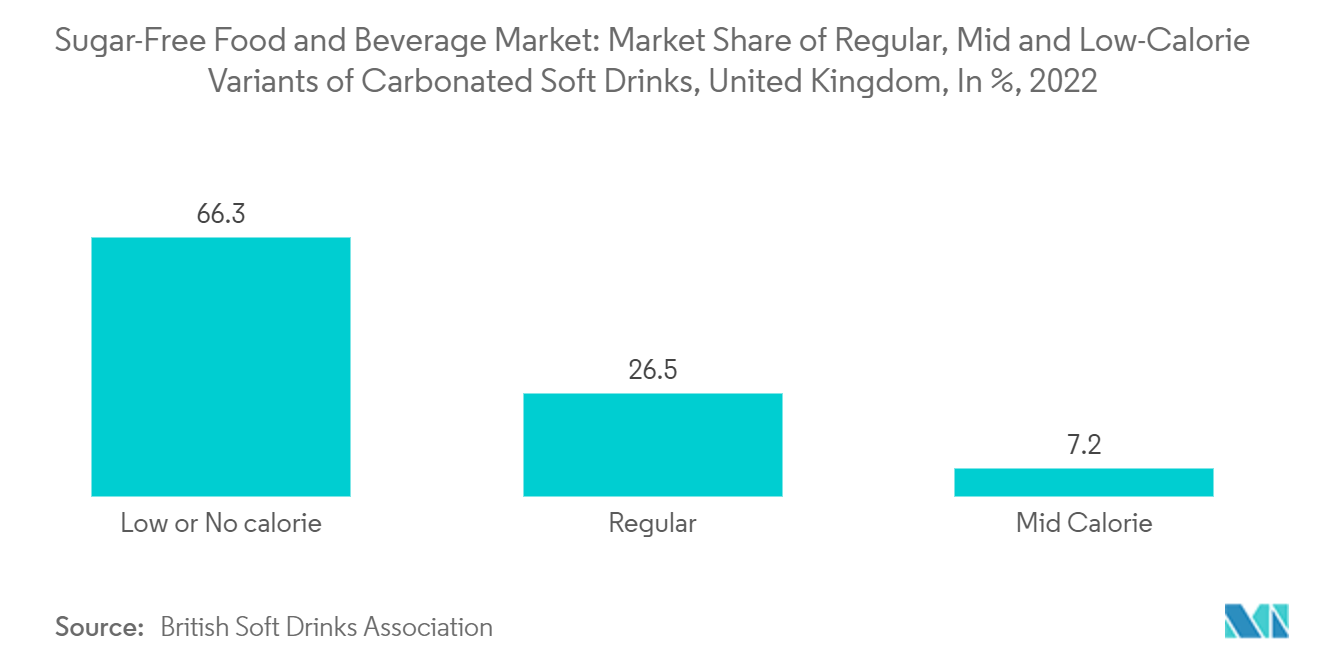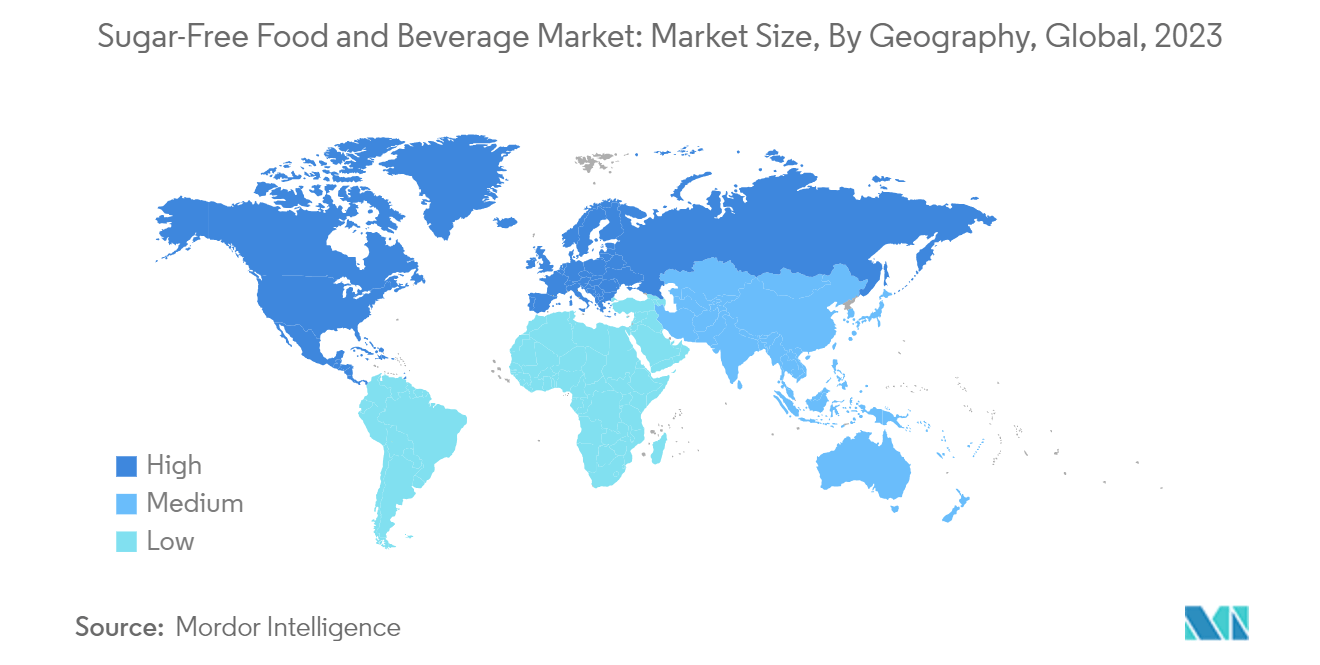Sugar-Free Food And Beverage Market Size
Sugar-Free Food And Beverage Market Analysis
The Sugar-Free Food And Beverage Market size is estimated at USD 20.12 billion in 2025, and is expected to reach USD 24.46 billion by 2030, at a CAGR of 3.98% during the forecast period (2025-2030).
The sugar-free food and beverage market has been experiencing significant growth in recent years due to various factors, including the rising demand for naturally sourced sweeteners, the shift toward premium products, the growing impact of e-commerce, and the changing consumer preference for healthier food and beverage choices. The rising health consciousness among consumers, particularly in regions like North America and Europe, is propelling the demand for alternatives to traditional sugary products. Concerns about diabetes, obesity, and other health issues associated with high sugar intake are leading individuals to seek out sugar-free options across various food and beverage categories. According to an article published by PubMed Central in April 2023, sugars were shown to be harmfully associated with various risk factors, including obesity, diabetes, cardiovascular disease, hyperuricemia, gout, ectopic fatty accumulation, dental caries, and some cancers.
Additionally, advances in food technology formulation techniques are enabling manufacturers to create innovative sugar-free products that closely mimic the texture as well as taste of their sugary counterparts, further fueling market growth. The new flavors are cherry, lemon, orange, and strawberry. Moreover, supportive regulatory environments and labeling requirements are encouraging the development and consumption of sugar-free products by providing consumers with clear information about sugar content and promoting healthier dietary choices. As a result, the sugar-free food and beverage market is expected to continue expanding as consumers increasingly prioritize health and wellness while making purchasing decisions.
Sugar-Free Food And Beverage Market Trends
Growing Trend of Consuming Sugar-free Beverages Creating Opportunities for Sugar-free Food & Beverage Segment
The trend of consuming sugar-free beverages is on the rise, and it is significantly driving the sugar-free food and beverage market. As consumers become more health conscious and aware of the negative impacts of excessive sugar consumption, they are actively seeking alternatives to traditional sugary beverages. The rise of dieting trends and wellness lifestyles has led consumers to prioritize low-calorie and sugar-free beverages as part of their dietary choices. Furthermore, the availability of a wide range of sugar-free beverage options, including diet sodas, flavored water, and sugar-free energy drinks, has made it easier for consumers to make a switch. Thus, the increasing demand for sugar-free beverages is not only driving innovation in the beverage industry but also spurring growth in the overall sugar-free food and beverage market.
In the past few years, numerous prominent traditional beverage companies and a few up-and-coming brands have embraced the trend and entered the market for sugar-free beverages, aiming to secure a share of it. Conversely, the World Health Organization (WHO) has urged all nations worldwide to implement substantial taxes on sugary drinks as a means to combat the global obesity and diabetes epidemic. This recommendation has prompted beverage manufacturers to embark on a journey of product range redesign, repositioning, and product formula verification as their primary strategy to cater to diverse demands, strengthen their consumer base, and consequently venture into the sugar-free beverage market.
North America Holds the Largest Market Share
With increasing concerns about health and wellness, North American consumers are actively seeking alternatives to traditional sugary products. The growing awareness of the adverse effects of excessive sugar consumption, such as diabetes and obesity, has driven individuals to opt for sugar-free options. In 2022, around 5% and 3% of people in the United States are suffering from obesity and diabetes, respectively, according to a survey conducted by Research America. Such factors create promising demand in the sugar-free food and beverage market in the United States.
US consumers, therefore, have accepted the sugar-free concept offerings very well. Thus, manufacturers have commenced repositioning and validating the recipe of their products as the primary strategy to cater to the diverse demands and strengthen their consumer base. For instance, in March 2022, MusclePharm, a global provider of leading sports nutrition and lifestyle branded nutritional supplements, launched a high whey protein drink line (Ready-To-Drink protein drink) with over 20 g of protein in multiple sugar-free flavors. Sugar-free products are heavily marketed in the region, making them accessible to consumers. Furthermore, the regulatory environment in the region, including labeling requirements and health guidelines, encourages the development and consumption of sugar-free products. Clear labeling of sugar content and the promotion of healthier eating habits contribute to the popularity of sugar-free food and beverages in the regional market.
Sugar-Free Food and Beverage Industry Overview
The global sugar-free food and beverages market is highly competitive, with many players operating worldwide. High investments in R&D activities and product innovation have led them to gain a major share of the global market. Some of the key players in the market include The Hershey Company, Nestle SA, PepsiCo Inc., Mars Incorporated, The Kraft Heinz Company, Hostess Brands Inc., Mondelez International Inc., Strauss Group Ltd, The Coca-Cola Company, and Kellanova. Key market players are focusing on mergers and acquisitions to expand their portfolios and cater to the interests of local consumers while also concentrating on acquiring new leading brands. Some of the players are also using social media platforms and campaigns to market and promote their products. For instance, in March 2022. Coca-Cola India launched a new campaign for its new brand, Coca-Cola Zero Sugar.
Sugar-Free Food and Beverage Market Leaders
-
The Hershey Company
-
Nestlé S. A
-
PepsiCo, Inc.
-
Mars Inc.
-
Kellanova
- *Disclaimer: Major Players sorted in no particular order
Sugar-Free Food and Beverage Market News
- March 2024: Volvic launched its newest creation, Touch of Fruit Sparkling Sugar Free, made with British spring water. In addition to this fresh product release, Volvic also revamped its Touch of Fruit till range to further entice consumers to explore the flavored water selection.
- February 2024: Nestlé Confectionery launched Fizzy Cactuz, a new sour, cacti-shaped gummy candy in Rowntree's Randoms line. The sweets come in four fruit flavors: raspberry, kiwi, passionfruit, and lime, and two textures: gummy and juicy fruit filling.
- February 2024: Kandy King launched sugar-free sweets to help people support their health and fitness goals. Their selection includes pre-packaged sugar-free sweets, such as mints, toffee, hard sweets, and chocolate, in 80 g bags.
- March 2023: Voortman Cookies launched zero-sugar mini wafers. The new mini wafers are available in two delectable flavors: vanilla and chocolate. The poppable, shareable wafers are baked with real vanilla or cocoa, include no high-fructose corn syrup, no artificial flavors or colors, and are packaged in resealable stand-up pouches.
Sugar-Free Food And Beverage Industry Segmentation
Sugar-free food and beverages are food products that contain no added sugars. According to the FDA, sugar-free foods are foods that have less than half a gram of added or naturally occurring sugar. The sugar-free food and beverage market is segmented into product type, distribution channel, and geography. The market is segmented by product type into beverages, dairy and dairy alternatives, confectionery, bakery products, dietary supplements, and other product types. Based on the distribution channel, the market can be segmented into supermarkets/hypermarkets, convenience stores, pharmacies/drug stores, online retail stores, and other distribution channels. Furthermore, the market is segmented based on geography worldwide, including North America, Europe, Asia-Pacific, South America, and the Middle East and Africa. For each segment, the market sizes and forecasts are offered on the basis of value (USD).
| Product Type | Beverages | ||
| Dairy and Dairy Alternatives | |||
| Confectionery | |||
| Bakery Products | |||
| Dietary Supplements | |||
| Other Product Types | |||
| Distribution Channel | Supermarkets/Hypermarkets | ||
| Convenience Stores | |||
| Pharmacies/Drug Stores | |||
| Online Retail Stores | |||
| Other Distribution Channels | |||
| Geography | North America | United States | |
| Canada | |||
| Mexico | |||
| Rest of North America | |||
| Europe | Spain | ||
| United Kingdom | |||
| Germany | |||
| France | |||
| Italy | |||
| Russia | |||
| Rest of Europe | |||
| Asia-Pacific | China | ||
| Japan | |||
| India | |||
| Australia | |||
| Rest of Asia-Pacific | |||
| South America | Brazil | ||
| Argentina | |||
| Rest of South America | |||
| Middle East and Africa | South Africa | ||
| Saudi Arabia | |||
| Rest of Middle East and Africa | |||
| Beverages |
| Dairy and Dairy Alternatives |
| Confectionery |
| Bakery Products |
| Dietary Supplements |
| Other Product Types |
| Supermarkets/Hypermarkets |
| Convenience Stores |
| Pharmacies/Drug Stores |
| Online Retail Stores |
| Other Distribution Channels |
| North America | United States |
| Canada | |
| Mexico | |
| Rest of North America | |
| Europe | Spain |
| United Kingdom | |
| Germany | |
| France | |
| Italy | |
| Russia | |
| Rest of Europe | |
| Asia-Pacific | China |
| Japan | |
| India | |
| Australia | |
| Rest of Asia-Pacific | |
| South America | Brazil |
| Argentina | |
| Rest of South America | |
| Middle East and Africa | South Africa |
| Saudi Arabia | |
| Rest of Middle East and Africa |
Sugar-Free Food and Beverage Market Research FAQs
How big is the Sugar-Free Food And Beverage Market?
The Sugar-Free Food And Beverage Market size is expected to reach USD 20.12 billion in 2025 and grow at a CAGR of 3.98% to reach USD 24.46 billion by 2030.
What is the current Sugar-Free Food And Beverage Market size?
In 2025, the Sugar-Free Food And Beverage Market size is expected to reach USD 20.12 billion.
Who are the key players in Sugar-Free Food And Beverage Market?
The Hershey Company, Nestlé S. A, PepsiCo, Inc., Mars Inc. and Kellanova are the major companies operating in the Sugar-Free Food And Beverage Market.
Which is the fastest growing region in Sugar-Free Food And Beverage Market?
Asia Pacific is estimated to grow at the highest CAGR over the forecast period (2025-2030).
Which region has the biggest share in Sugar-Free Food And Beverage Market?
In 2025, the North America accounts for the largest market share in Sugar-Free Food And Beverage Market.
What years does this Sugar-Free Food And Beverage Market cover, and what was the market size in 2024?
In 2024, the Sugar-Free Food And Beverage Market size was estimated at USD 19.32 billion. The report covers the Sugar-Free Food And Beverage Market historical market size for years: 2019, 2020, 2021, 2022, 2023 and 2024. The report also forecasts the Sugar-Free Food And Beverage Market size for years: 2025, 2026, 2027, 2028, 2029 and 2030.
Page last updated on: August 22, 2024
Sugar-Free Food and Beverage Industry Report
The Sugar-Free Food and Beverage Market Report provides a comprehensive industry analysis, encompassing various product types such as beverages, dairy and dairy alternatives, confectionery, bakery products, dietary supplements, and other product types. The report also delves into the distribution channels, including supermarkets/hypermarkets, convenience stores, pharmacies/drug stores, online retail stores, and other distribution channels.
The market analysis highlights the industry outlook, focusing on market growth and market segmentation across different geographies, including North America, Europe, Asia-Pacific, South America, and the Middle East and Africa. The industry reports offer valuable insights into market trends and the market forecast, providing a detailed market overview and market review.
The report also sheds light on the market size and market share, along with industry statistics and industry size. The market data and market value are thoroughly examined to understand the market predictions and market outlook for the sugar-free food and beverage market.
In addition to the market analysis, the report includes industry information and industry research, offering a comprehensive report example and a report PDF for further reference. The industry sales and growth rate are also discussed, highlighting the performance of market leaders in the industry.
Overall, this industry report serves as a valuable resource for research companies and provides a detailed understanding of the sugar-free food and beverage market, including market trends and industry trends.





.webp)

